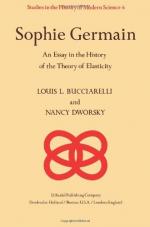|
This section contains 283 words (approx. 1 page at 300 words per page) |
French Mathematician 1776–1831
Sophie Germain is remembered for her work in the theory of numbers and in mathematical physics. Germain was born in Paris to a father who was a wealthy silk merchant. She educated herself by studying books in her father's library, including the works of Sir Isaac Newton and the writings of mathematician Leonhard Euler.
When the École Polytechnique opened in 1794, even though women were not allowed to attend as regular students, Germain obtained lecture notes for courses and submitted papers using the pseudonym M. LeBlanc. One of the instructors, noted scientist Joseph-Louis Lagrange, became her mentor.
In 1804 Germain began to correspond with German mathematician Carl Friedrich Gauss, sending him discoveries she made in number theory. Among these was a limited proof of Fermat's Last Theorem, her best known contribution to mathematics. This theorem was finally proved in 1994 using her approach. Germain also corresponded with mathematician Adrien Marie Legendre, who used her suggestions in one of his publications.
In mathematical physics, Germain is known for her work in acoustics and elasticity. She won a prize from the French Academy of Sciences in 1816 for the development of mathematical models for the vibration of elastic surfaces. Subsequently, she was invited to attend sessions of the Academy of Sciences and the Institut de France, but because she was a woman, she could never join either group.
 Sophie Germain's foundational work on Fermat's Last Theorem stood unmatched for more than 100 years.
Sophie Germain's foundational work on Fermat's Last Theorem stood unmatched for more than 100 years.
See Also
Euler, Leonhard; Fermat's Last Theorem; Newton, Sir Isaac.
Bibliography
Gray, Mary W. "Sophie Germain (1776–1831)," in Women of Mathematics. Edited by Louise S. Grinstein and Paul J. Campbell. New York: Greenwood Press, 1987.
Ogilvie, Marilyn Bailey. Women in Science. Cambridge, MA: MIT Press, 1986.
|
This section contains 283 words (approx. 1 page at 300 words per page) |


